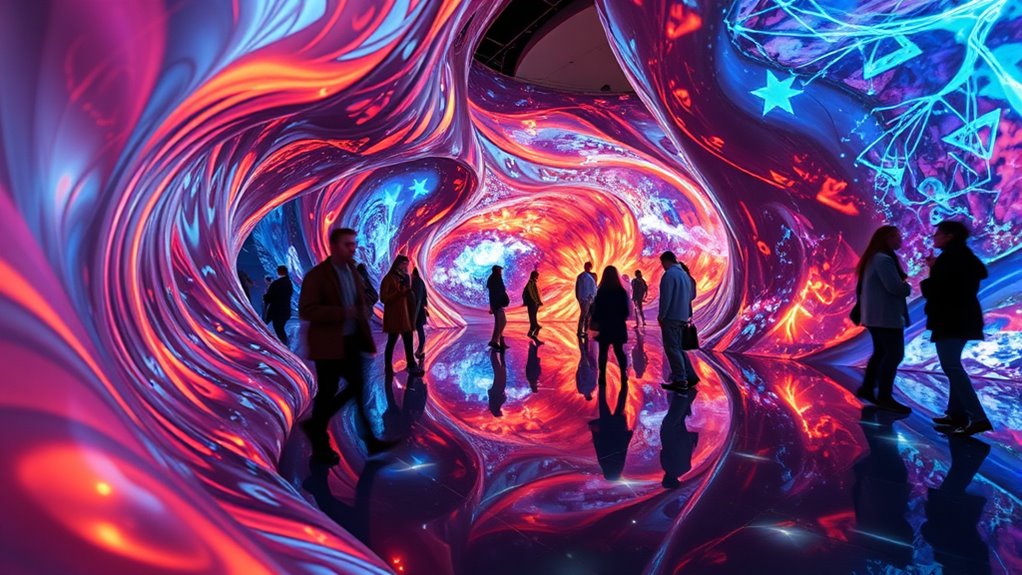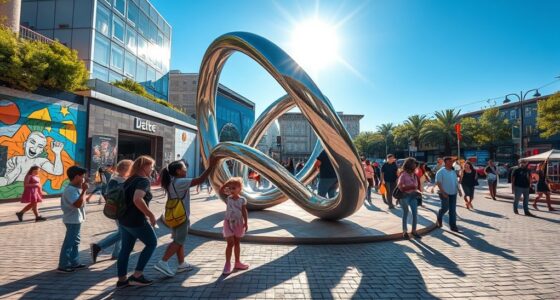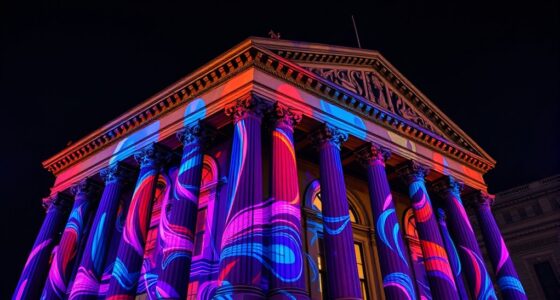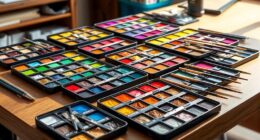Phygital experiences blend physical and digital art worlds to create immersive, interactive moments that engage your senses and emotions. By combining traditional artworks with AR, VR, sensors, and blockchain, you can explore new ways of experiencing and owning art. These innovations break physical boundaries, making art more accessible and participatory. If you’re curious about how these technologies are transforming art spaces and opening new possibilities, keep exploring to discover more about this exciting fusion.
Key Takeaways
- Phygital experiences seamlessly blend physical artworks with digital elements like AR, sensors, and NFTs to enhance engagement and immersion.
- Technologies such as AR, VR, and blockchain enable interactive, personalized, and verifiable digital-physical art integrations.
- Immersive environments use multisensory stimuli—light, sound, tactile, and aromas—to deepen emotional and sensory connections.
- Virtual galleries and online platforms expand access, allowing global audiences to experience and participate in hybrid art exhibitions.
- Challenges include maintaining authenticity, adapting to rapid tech changes, and balancing traditional curation with digital innovation.
Defining the Concept of Phygital Art

While the term “phygital” may be new to many, it simply combines “physical” and “digital” to describe experiences that seamlessly blend both domains. In phygital art, you create a space where traditional artwork interacts with digital elements, enhancing engagement. Think of sculptures embedded with sensors that trigger digital projections or paintings that come alive through augmented reality. This fusion allows you to break free from the limitations of physical art while preserving its tangible qualities. You become part of a dynamic environment where the boundaries between the real and virtual blur, offering immersive experiences that captivate your senses. Phygital art invites you to explore new ways of perceiving and interacting with creative expressions, redefining what art can be in the modern world. Additionally, incorporating anime-inspired themes into digital art projects can deepen emotional connections and expand creative possibilities.
The Evolution of Art: From Traditional to Digital

The evolution of art reflects humanity’s ongoing desire to push creative boundaries, shifting from traditional methods to innovative digital practices. You’ve seen artists move from canvases and sculptures to using computers, tablets, and virtual tools. This progression has expanded possibilities, enabling new forms of expression. Digital art offers features like interactivity, instant sharing, and limitless experimentation. You can explore:
- The rise of digital platforms for art creation and distribution
- The emergence of virtual galleries and online exhibitions
- The use of augmented reality to enhance artworks
- The blending of multimedia elements in digital compositions
- Access to global audiences without physical boundaries
- The integration of digital art technology into traditional art forms, creating hybrid experiences that bridge physical and virtual worlds
This evolution keeps pushing the limits of what art can be, opening doors for more dynamic, accessible, and innovative experiences.
Technologies Powering Phygital Experiences
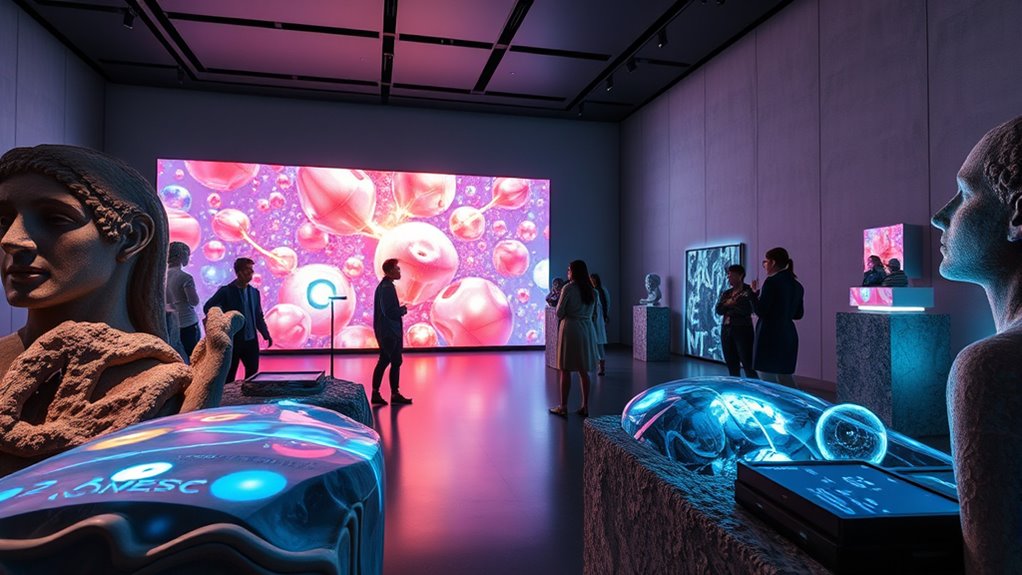
Augmented reality tools transform how you interact with physical spaces, blending digital information seamlessly into the real world. Blockchain and NFTs establish secure, verifiable ownership, making digital assets more tangible. Together, these technologies drive innovative phygital experiences that redefine engagement and value. Additionally, Mazda Tuning techniques exemplify how technological enhancements can personalize and optimize experiences, whether in automotive performance or digital interactions.
Augmented Reality Tools
Augmented Reality (AR) tools are transforming how you interact with digital and physical environments by overlaying virtual elements onto the real world. They enable immersive experiences that blend art, commerce, and entertainment seamlessly. With AR, you can visualize artworks in your space before purchasing, explore interactive gallery displays, or participate in live digital scavenger hunts. These tools are powered by advanced sensors, cameras, and software that detect your environment and position virtual objects accurately. You might notice:
- Real-time object recognition
- Location-based content triggers
- Interactive 3D models
- Virtual try-ons for art or fashion
- Enhanced storytelling through overlays
AR brings a dynamic layer to physical art worlds, making experiences more engaging, personalized, and accessible. Additionally, the integration of high refresh rates and contrast ratios in AR devices enhances visual clarity and realism, further enriching the immersive experience.
Blockchain and NFTs
Blockchain and NFTs are revolutionizing how you connect physical and digital assets by providing secure, transparent, and verifiable ownership. They enable you to tokenize physical items like artwork, collectibles, or fashion, creating unique digital certificates stored on a blockchain. This ensures authenticity and prevents forgery. When you buy an NFT, you’re acquiring proof of ownership that’s easily transferable and publicly recorded, fostering trust in the transaction. Artists and brands leverage these technologies to bridge the physical and digital domains, offering exclusive experiences or limited-edition items. Blockchain’s decentralized nature reduces fraud, while NFTs give you a way to prove provenance and rarity. Together, they empower you to participate in a new era of art collection, ownership, and commerce that blends the tangible and virtual seamlessly. Additionally, the integration of keto diet tracking apps demonstrates how digital tools can enhance real-world lifestyle choices, further exemplifying the blending of physical and digital experiences.
Interactive Installations and Immersive Exhibits
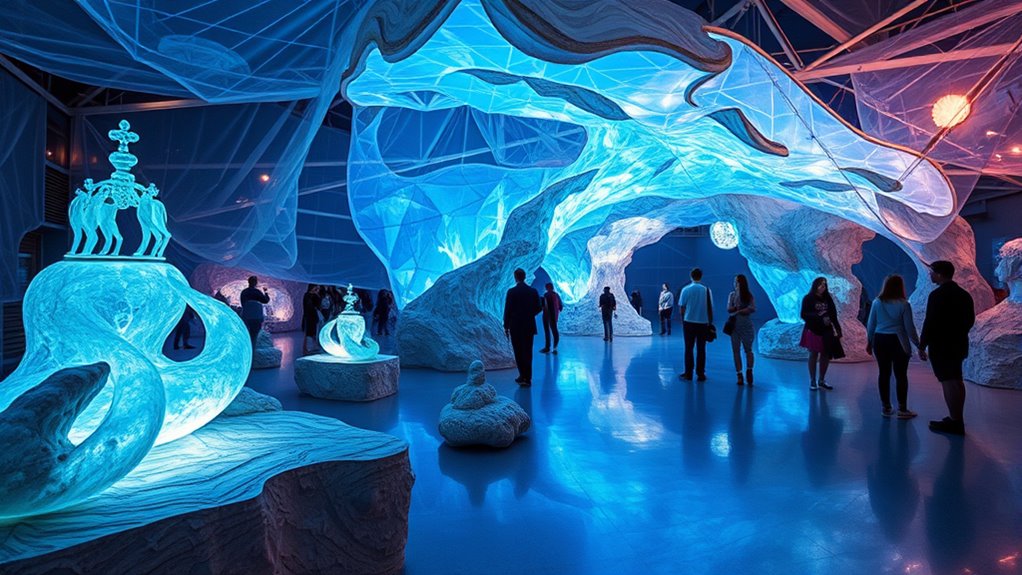
Interactive installations and immersive exhibits captivate you by offering engaging user interactions that invite exploration. They seamlessly combine digital elements with physical spaces, creating fluid experiences that feel natural and intuitive. These environments stimulate your senses, making every moment immersive and memorable. Understanding operating hours of nearby venues can enhance your experience by allowing you to plan visits during optimal times.
Engaging User Interactions
Have you ever stepped into a space where technology seamlessly responds to your movements and actions? That’s the magic of engaging user interactions in phygital art experiences. These setups invite you to become part of the artwork, blurring the lines between observer and participant. You might:
- Control visuals with your gestures
- Solve interactive puzzles triggered by your proximity
- Influence soundscapes through movement
- Navigate immersive environments with touch or motion
- Receive personalized feedback based on your choices
Such interactions create memorable moments, encouraging exploration and emotional engagement. They foster a sense of agency, making you feel connected to the art on a deeper level. By combining physical presence with digital responsiveness, these exhibits transform passive viewing into active participation, enriching your overall experience. Incorporating elements like Bedroom themes can also evoke a sense of comfort and familiarity within immersive environments.
Seamless Digital Integration
Seamless digital integration transforms physical spaces into immersive environments where technology and design work together effortlessly. You can create interactive installations that respond to your movements, touch, or voice, making each visit unique. Immersive exhibits blend digital displays, projection mapping, and sensors to craft dynamic experiences. Instead of separate elements, everything flows together, so visitors feel fully engaged without distractions. This integration enhances storytelling, allowing artists and curators to craft compelling narratives that unfold naturally. It also simplifies the user experience; you don’t need technical expertise to navigate or interact. By bridging the physical and digital seamlessly, you’re immersed in environments that feel both intuitive and innovative, elevating the overall art experience and encouraging deeper engagement with the exhibit’s message. Digital integration creates cohesive environments where technology enhances aesthetic appeal and functionality.
Sensory Immersive Environments
Building on the integration of digital and physical environments, sensory immersive experiences heighten engagement by appealing directly to your senses. These installations surround you with sights, sounds, textures, and even smells that deepen your connection to the art. You might walk through a room where projections change with your movements or touch surfaces that react with light and sound. These environments create a sense of presence, making you feel part of the artwork itself. To capture your attention, creators often incorporate:
- Multisensory stimuli that respond to your actions
- Dynamic lighting that shifts with your movement
- Interactive soundscapes triggered by presence
- Tactile elements you can touch and explore
- Aromas that complement visual displays
This immersive approach transforms passive observation into active participation, heightening your emotional and sensory experience. Incorporating Snacks – Mad Tasting elements can even enhance the overall sensory immersion by engaging your taste buds in the experience.
The Role of Augmented and Virtual Reality in Art

Augmented and virtual reality are transforming how artists create and audiences experience art, immersing viewers in environments that were previously impossible to access. With AR, you can overlay digital elements onto physical spaces, enhancing traditional artworks or transforming galleries into interactive experiences. VR, on the other hand, transports you to entirely new worlds, where you can explore immersive installations or walk through virtual exhibitions from anywhere. These technologies enable you to engage with art on a deeper level, feeling present within a piece or environment. Artists leverage AR and VR to push creative boundaries, offering personalized, interactive encounters that blend physical and digital domains. As a viewer, you become an active participant, experiencing art in ways that challenge conventional perceptions and foster new forms of connection.
Digital Collectibles and Blockchain in the Art World

As digital technology continues to reshape how we experience and value art, blockchain has emerged as a powerful tool for creating and authenticating digital collectibles. You can now own unique digital assets, like limited edition artworks or animations, verified securely on the blockchain. This technology guarantees provenance, reducing forgery and increasing trust. Additionally, understanding emergency preparedness essentials can help creators and collectors alike safeguard their digital assets during unforeseen disruptions. Consider these key points:
- Digital certificates of authenticity for art pieces
- Limited edition NFTs that increase scarcity
- Transparent ownership records
- Direct artist-to-collector transactions
- New revenue streams for creators
Challenges and Opportunities for Artists and Institutions
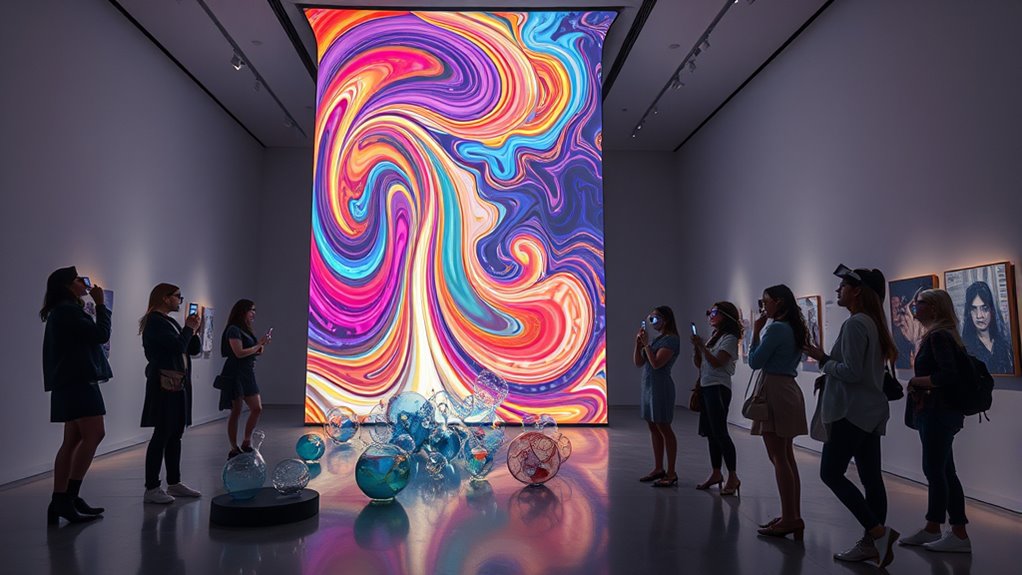
While digital innovations open exciting new pathways for artists and institutions, they also present significant challenges. You may struggle with maintaining authenticity and protecting your intellectual property in an increasingly digital space. The rapid pace of technological change can make it difficult to keep up and adapt your practices effectively. Additionally, reaching and engaging diverse audiences requires new strategies and skills. For institutions, balancing traditional curatorial methods with digital integration demands resources and careful planning. On the positive side, these challenges create opportunities to innovate and expand your reach. You can explore new revenue streams through digital sales or virtual exhibitions. Embracing these changes allows you to connect more deeply with audiences worldwide, fostering engagement and creating fresh, immersive experiences that bridge physical and digital art worlds.
Case Studies of Successful Phygital Projects

Have you ever wondered how museums seamlessly blend physical exhibits with digital technology to create immersive experiences? One standout example is the Van Gogh Museum’s digital reinterpretation, where visitors use AR to explore artworks in new ways. Another is Sotheby’s virtual auctions, which combine physical art with online bidding, expanding reach worldwide. The team behind the Museum of the Future in Dubai integrated interactive displays with physical installations, creating an engaging environment. Additionally, the Levi’s Stadium used digital projections to enhance live events, blending real-world and digital visuals. Ultimately, the team behind the Pokémon Center in Tokyo incorporated augmented reality to bring characters into the physical space. These projects demonstrate how successful phygital initiatives can revolutionize engagement and accessibility in the art world.
Future Trends in Merging Physical and Digital Art
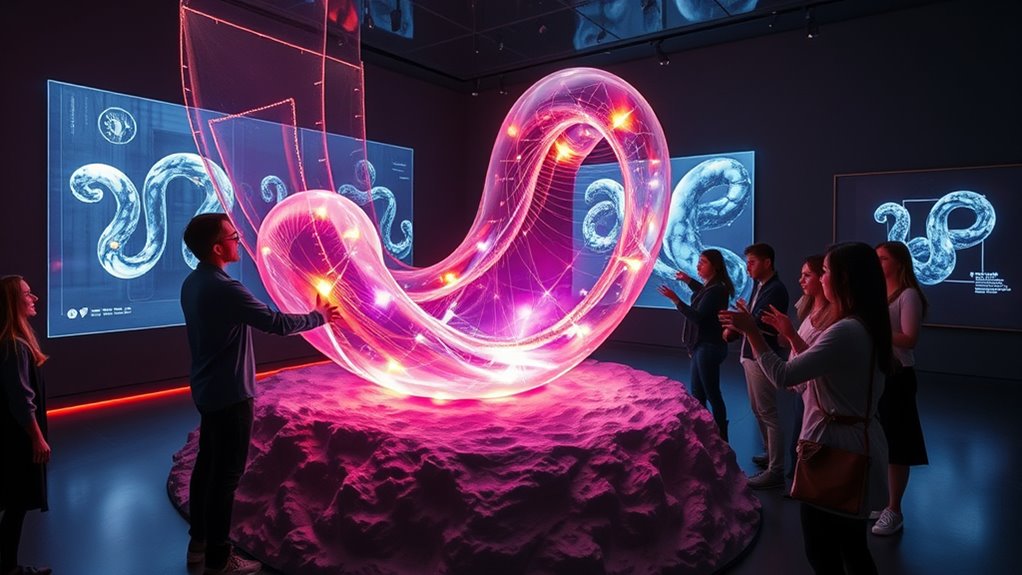
The future of merging physical and digital art is poised to transform how audiences experience creativity, driven by rapid technological advancements. Expect increased use of augmented reality (AR) and virtual reality (VR), making art more immersive and interactive. Artists will leverage blockchain to authenticate and sell digital artworks as NFTs, creating new revenue streams. AI will play a bigger role, helping craft personalized, dynamic art pieces that respond to viewer engagement. You’ll see more hybrid installations blending physical sculptures with digital projections, blurring boundaries further. As technology becomes more accessible, audiences will participate more actively in art creation and curation. This evolution will make art more inclusive, engaging, and interconnected, reshaping the way you explore and connect with creative expressions across physical and digital domains.
Frequently Asked Questions
How Do Artists Monetize Phygital Artworks Effectively?
You monetize phygital artworks effectively by offering limited editions, exclusive access, and digital ownership rights like NFTs. You can also create immersive experiences or merchandise that blend physical and digital elements, encouraging collectors to invest. Partner with galleries or online platforms to reach broader audiences, and leverage social media to showcase the uniqueness of your work. Engaging your community and providing value drives sales and builds loyalty.
What Are the Ethical Considerations in Digital Art Authentication?
You might think digital art authentication is a walk in the park, but it’s more like steering a minefield. Ethically, you must avoid fakes, protect artist rights, and guarantee transparency. Don’t let blockchain hype fool you—false claims and digital forgeries threaten trust. Stay honest, verify provenance rigorously, and respect intellectual property. After all, in the digital age, integrity isn’t just a virtue; it’s your best armor.
How Accessible Are Phygital Experiences to Diverse Audiences?
You can find phygital experiences increasingly accessible, but barriers remain. As a participant, you might face challenges like digital literacy gaps, limited access to high-speed internet, or lack of physical venues. Efforts are underway to make these experiences more inclusive by designing user-friendly interfaces, offering multilingual options, and expanding access points. Still, ensuring true diversity requires ongoing commitment from creators and platforms to address these disparities proactively.
What Are the Environmental Impacts of Digital Art Technologies?
Digital art technologies can have significant environmental impacts, from high energy consumption to electronic waste. You might reduce your footprint by choosing energy-efficient devices, supporting sustainable tech initiatives, and recycling outdated equipment. By being mindful of your digital habits, you help minimize pollution, conserve resources, and promote eco-friendly practices. Your choices matter—every step toward sustainability in digital art helps protect the planet for future generations.
How Can Collectors Verify the Authenticity of Digital Assets?
To verify the authenticity of digital assets, you should check their blockchain records or certificates of authenticity provided by reputable platforms. Always look for verified creators and use trusted marketplaces that authenticate and track provenance. You can also utilize digital signatures or watermarking tools embedded in the artwork. By doing these steps, you guarantee your digital collection is genuine and protected from fraud or duplication.
Conclusion
You might think blending physical and digital art risks losing authenticity, but imagine walking into an exhibit where a sculpture transforms into a dynamic digital display right before your eyes. Phygital experiences create immersive, tangible connections that enhance your engagement. Embracing this fusion, you can explore innovative ways to appreciate art, making each visit unforgettable. The future of art isn’t just digital or physical—it’s a seamless, vibrant world waiting for you to discover.
